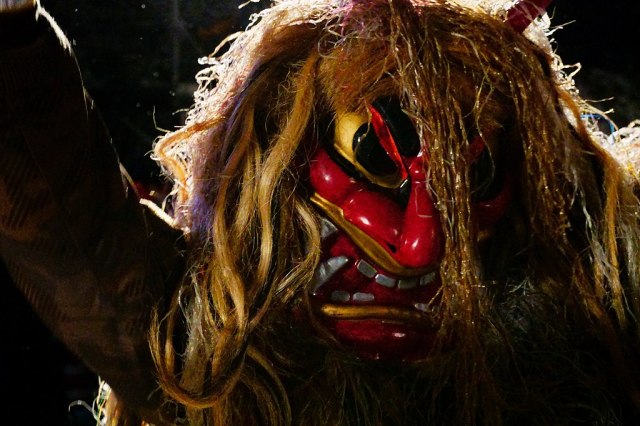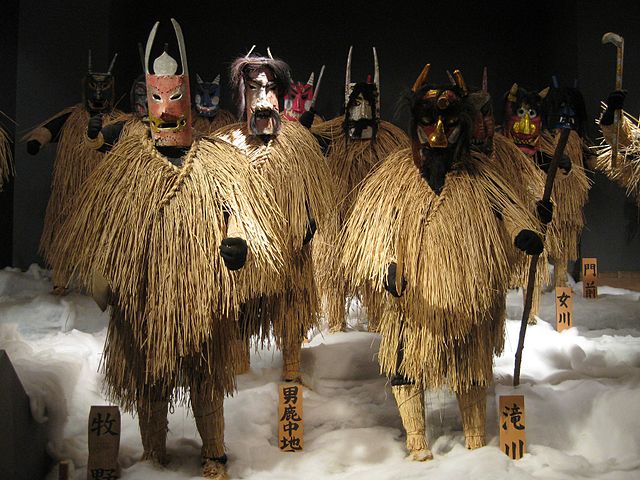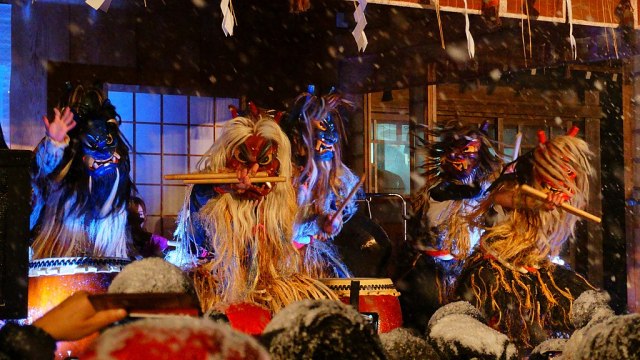
Unfortunately, kids in northern Japan don’t get a pass this year from the UNESCO-recognized, fearsome namahage.
Japan is host to a variety of traditions and rituals, some which are hundreds of years old or which have made a recent comeback. However, with the impact of COVID-19 this year, several traditional Japanese festivals and customs have been adjusted for safety concerns, and the same goes for the northern Japanese tradition of namahage in Akira prefecture’s Oga city.
▼ An assortment of namahage costumes from local areas in Akita’s Namahage Museum.
Added to UNESCO’s Intangible Cultural Heritage of Humanity list two years ago, namahage are part of an annual New Year’s Eve tradition where male volunteers dress up as straw cloak-wearing, paper mache knife-bearing oni, or ogres, who find and eat disobedient children. The typical namahage routine in Japanese villages involves visiting local homes while threateningly saying “Any naughty children around?” Another important part of the tradition as well also includes preparing a tribute of sake and mochi, or sticky rice cake, for the namahage to drink and eat.
But with COVID-19-related fears abound, things will be different for the nearly 200-year-old tradition.
▼ Other activities involving nahamage include taiko, or traditional Japanese drum performances.
For this year, as part of COVID-19 preventative measures, namahage will not be entering homes and community organizers ask that local households refrain from providing the usual spread of alcohol as well as food. Volunteers helping with the tradition will also be expected to wear face masks. However, the experience won’t be entirely lost as it’s been decided that the namahage will instead stick to roaming the streets, no doubt shouting their signature catchphrase, “Any naughty children around?” and waving a paper mache knife.
▼ No more crowds either for the time being.
Ritual-bound traditions play an important role in local communities and serve as a homage to the distinctive cultures that every region of Japan has. And while these are simply temporary measures for the namahage, hopefully in the future things will wind down enough that guests of the region can experience the special tradition of namahage while enjoying some fresh seafood.
Source: NHK
Top image: Wikipedia/掬茶
Insert image: Wikipedia/Douglas P Perkins, Wikipedia/掬茶 (1, 2)
● Want to hear about SoraNews24’s latest articles as soon as they’re published? Follow us on Facebook and Twitter!



 Yakuza leadership airs complaints about COVID-19’s effect on money gains and operations
Yakuza leadership airs complaints about COVID-19’s effect on money gains and operations Statue of comedian Ken Shimura erected a year after death from COVID-19
Statue of comedian Ken Shimura erected a year after death from COVID-19 Lacquerware supplier to emperor of Japan and Pokémon team up for new tableware
Lacquerware supplier to emperor of Japan and Pokémon team up for new tableware Can a dirty butthole make you filthy rich in Japan? We’re starting a New Year’s lottery experiment
Can a dirty butthole make you filthy rich in Japan? We’re starting a New Year’s lottery experiment Large amount of supposed human organs left in Osaka marketplace
Large amount of supposed human organs left in Osaka marketplace A Japanese dating app matched our bachelorette with a Buddhist monk, and she learned some things
A Japanese dating app matched our bachelorette with a Buddhist monk, and she learned some things Disillusionment at Tsukiji’s tourist-target prices led us to a great ramen restaurant in Tokyo
Disillusionment at Tsukiji’s tourist-target prices led us to a great ramen restaurant in Tokyo Oh Boy, That’s Pretty Racist (Part Two): Japanese woman explains why Taiwanese girls suck
Oh Boy, That’s Pretty Racist (Part Two): Japanese woman explains why Taiwanese girls suck New product aimed at Japanese women and cosplayers helps to create a slimmer, taller nose
New product aimed at Japanese women and cosplayers helps to create a slimmer, taller nose Chowing down on dirt-cheap gyoza and insane portions at Fukuoka’s Gyoza Supermarket Pub
Chowing down on dirt-cheap gyoza and insane portions at Fukuoka’s Gyoza Supermarket Pub Is this the most relaxing Starbucks in Japan?
Is this the most relaxing Starbucks in Japan? 7-Eleven Japan starts new temporary luggage storage service in over 300 branches
7-Eleven Japan starts new temporary luggage storage service in over 300 branches Starbucks teams up with 166-year-old Kyoto doll maker for Year of the Horse decorations【Photos】
Starbucks teams up with 166-year-old Kyoto doll maker for Year of the Horse decorations【Photos】 Japan may add Japanese language proficiency, lifestyle classes to permanent foreign resident requirements
Japan may add Japanese language proficiency, lifestyle classes to permanent foreign resident requirements Starbucks Japan releases new zodiac chilled cup drink for 2026
Starbucks Japan releases new zodiac chilled cup drink for 2026 Tokyo’s Tsukiji sushi neighborhood asks tour groups to stay away for the rest of the month
Tokyo’s Tsukiji sushi neighborhood asks tour groups to stay away for the rest of the month Starbucks on a Shinkansen bullet train platform: 6 tips for using the automated store in Japan
Starbucks on a Shinkansen bullet train platform: 6 tips for using the automated store in Japan Street Fighter Hadouken Churros to be launched and eaten in Tokyo, Okami pudding on offer too
Street Fighter Hadouken Churros to be launched and eaten in Tokyo, Okami pudding on offer too Japan’s human washing machines will go on sale to general public, demos to be held in Tokyo
Japan’s human washing machines will go on sale to general public, demos to be held in Tokyo Japanese train company is letting fans buy its actual ticket gates for their homes
Japanese train company is letting fans buy its actual ticket gates for their homes Tokyo considering law requiring more trash cans following litter increase in heavily touristed area
Tokyo considering law requiring more trash cans following litter increase in heavily touristed area Nintendo’s Kirby now delivering orders at Kura Sushi restaurants, but not in Japan
Nintendo’s Kirby now delivering orders at Kura Sushi restaurants, but not in Japan Tokyo event lets you travel back in time, for free, to celebrate 100 years since Showa era start
Tokyo event lets you travel back in time, for free, to celebrate 100 years since Showa era start Sanrio theme park in Japan announces plans to expand into a Sanrio resort
Sanrio theme park in Japan announces plans to expand into a Sanrio resort Survey asks foreign tourists what bothered them in Japan, more than half gave same answer
Survey asks foreign tourists what bothered them in Japan, more than half gave same answer Japan’s deadliest food claims more victims, but why do people keep eating it for New Year’s?
Japan’s deadliest food claims more victims, but why do people keep eating it for New Year’s? We deeply regret going into this tunnel on our walk in the mountains of Japan
We deeply regret going into this tunnel on our walk in the mountains of Japan Studio Ghibli releases Kodama forest spirits from Princess Mononoke to light up your home
Studio Ghibli releases Kodama forest spirits from Princess Mononoke to light up your home Major Japanese hotel chain says reservations via overseas booking sites may not be valid
Major Japanese hotel chain says reservations via overseas booking sites may not be valid Put sesame oil in your coffee? Japanese maker says it’s the best way to start your day【Taste test】
Put sesame oil in your coffee? Japanese maker says it’s the best way to start your day【Taste test】 The top 10 annoying foreign tourist behaviors on trains, as chosen by Japanese people【Survey】
The top 10 annoying foreign tourist behaviors on trains, as chosen by Japanese people【Survey】 No more using real katana for tourism activities, Japan’s National Police Agency says
No more using real katana for tourism activities, Japan’s National Police Agency says Starbucks Japan reveals new sakura drinkware collection, inspired by evening cherry blossoms
Starbucks Japan reveals new sakura drinkware collection, inspired by evening cherry blossoms
Leave a Reply